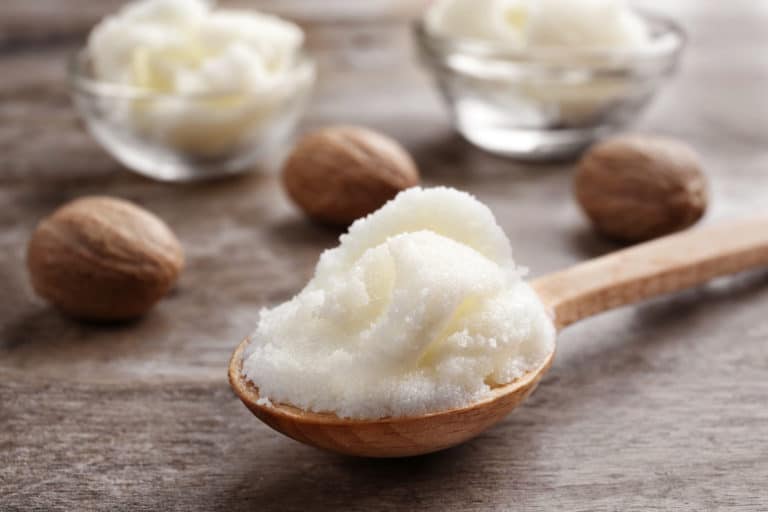Shea-butter

Shea-butter is an aromatically scented natural cream with a very high content of highly effective substances. It is obtained from the fruits of the shea tree (Vitellaria paradoxa). This special tree grows about 10 to 15 metres high and is a natural part of the vegetation in the so-called sub-Sahel zone, a strip of vegetation more than 250 kilometres wide that stretches from the West African country of Mali through Togo, Ghana, and Burkina Faso to Benin. This is the only place where the shea tree, which does not flower for the first time until it is 20 years old, can be found.
How is Shea-butter extracted?
The slightly plum-shaped green fruits have a diameter of about four centimetres. The edible flesh surrounds a kernel: the shea nut from which Shea-butter is extracted. The production process is complex: After harvesting and drying the fruit, the pulp must first be removed. Once the extracted kernels are also sufficiently dried, they are mechanically squeezed. Even today, women still very often grind the nuts traditionally by hand and with pestles to a slightly brownish mass. In the meantime, however, some women’s cooperatives have modern machines that take over at least some of the strenuous manual work.
The resulting pure oil can now be processed into Shea-butter. Unrefined Shea-butter is a white-yellow and spicy-smelling mass. It is almost always an organic product, as shea nuts mainly come from wild collections. The butter is characterised by many positive properties and an unusually long shelf life of maximum three years. It is used in the food sector as a substitute fat for cocoa butter in chocolate production and is a common ingredient for organic stock cubes.
Shea-butter in cosmetics
The warmer the climatic conditions in which the shea tree thrives, the more active its production of cell-protecting and antioxidant tocopherols.
In the African Sahara, Shea-butter has an almost life-sustaining function: it protects the skin of the people living there against the drying wind. The African peoples also use it for skin care, rheumatism, joint and muscle pain, baby care and as a preventative against stretch marks. There is of course a reason why Shea-butter is used in so many ways in its homeland. Its extraordinarily high content of vitamin E, carotene and allantoin makes it particularly good for the skin. Allantoin, for example, has a positive influence on cell formation and cell structure and soothes the skin, which is why Shea-butter is often used in creams and cosmetic products to relieve inflammation. Shea-butter also smoothes the skin and makes it soft and supple, as it has moisturising properties. Especially the unsaponifiable components create a very pleasant skin feeling due to their excellent moisture-binding properties. Another positive effect: it even regulates cornification disorders and can support wound healing in the case of minor injuries.
Ideal for dry skin
The application is recommended for dry skin that is low in oil and water or has severe scaling. Those who suffer from occupationally damaged skin or extremely dry elderly skin can also achieve very good results with cosmetic products containing Shea-butter. Shea-butter is usually very well tolerated and is also suitable for skin that is prone to allergies.
It is highly valued by the cosmetics industry and is being used in more and more skin care products. However, it is usually used in a refined form. In Europe, the use of unrefined Shea-butter is still more of an insider tip, whereas in Africa, the skin care product is still exclusively used unrefined.
The pure yellowish-greenish Shea-butter contains most of the active ingredients and secondary plant components, but it also has an intense odour.
In formulations, Shea-butter acts as a natural consistency enhancer. It makes for supple creams that are easy to apply. Due to its high content of unsaponifiables and oleic acid, it also has a high penetration capacity.
Fact Sheet Shea-butter
CAS number: 194043-92-0
INCI: Butyrospermum Parkii (Shea) Butter
Melting range: 24 to 38 degrees Celsius
Saponification number: 165 to 188
Composition: Oleic acid (40 to 60 percent), stearic acid (25 to 50 percent), unsaponifiables (mainly beta-sitosterol, stigmasterol, campesterol), tocopherols, vitamin A, phenols, catechins, triterpenes
Use in cosmetics: universally applicable lipid, particularly effective for dry and cracked skin, neurodermatitis, dermatoses and in lip balms. Ideal ointment base
Conclusion: The “sacred gift of Africa” is enormously valuable cosmetically.
Due to its high fat content, Shea-butter can effectively protect the skin from drying out and bind moisture to the epidermis. It is well tolerated and is also used in the production of lip balms, nose and breast ointments as well as in creams against stretch marks.
Feel free to ask us if you would like products developed with Shea-butter.
Literature:
Anti-Inflammatory and Skin Barrier Repair Effects of Topical Application of Some Plant Oils.
Lin TK, Zhong L, Santiago JL.Int J Mol Sci. 2017 Dec 27;19(1):70.
Hon KL, Tsang YC, Pong NH, Lee VW, Luk NM, Chow CM, Leung TF.Hong Kong Med J. 2015 Oct;21(5):417-25
Megnanou RM, Niamke S.Springerplus. 2015 Nov 4;4:667.
Poljšak N, Kočevar Glavač N.Front Pharmacol. 2022 Apr 25;13:868461